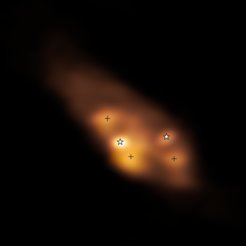Hot spots around infant binary stars
High-resolution ALMA observations of the system IRAS 16293-2422 have revealed localized hot spots in the dusty material of the young stellar system. The study led by the Max Planck Institute of Extraterrestrial Physics indicates that these are most likely due to local shocks caused by fast gas motions rather than illumination from the protostars. This suggests that heat produced in shocks is an important factor during the early stages of the formation of protostars and the planetary disks around them. Such shocks could be caused by localized accretion of material from the surrounding envelope or by local fragmentation due to gravitational instabilities.
Astronomers have been studying the area around protostars to learn more about not only star formation in general, but also to find out more about the conditions and processes that might have led to the creation of our own Solar System. In particular, infant stars with a mass close to that of our Sun are highly interesting. About half of all Sun-like stars are actually found in the company of other stars like the binary in the system IRAS 16293-2422, which was discovered by a team of astronomers at the Max Planck Institute for Extraterrestrial Physics (MPE) in 2020.

When taking a closer look at the system with very high-resolution ALMA observations, the team found that the two stars in the system are not the only source of heat. “We were able to zoom in on the central region and found that the hot dust is not correlated with the positions of the protostars,” says María José Maureira, the postdoctoral researcher who led the study at MPE. “Surprisingly, we found localized hot spots, which are likely produced by local shock waves in the gas, like the shock waves produced when an airplane travels faster than the sound speed through air.“
Such shocks can alter the chemical composition of the gas and dust clouds, as molecules previously frozen out in ice mantles around the dust grains are released. Organic molecules in space are the potential precursors to more complex molecules essential to life. Such shocks can therefore alter the chemical composition and the amount of material that can stick together, changing the properties of the resultant planetary systems.
“These fascinating new observations reveal that our current disk models are incomplete and that they must include some extra source of heating,” points our Jaime Pineda, a co-author at MPE. “This will modify the way we estimate dust properties and masses of these young disks.”
The new temperature maps of the dust agree very well with previous observations of light emitted by certain molecules. “These observations allowed us to unveil the physical conditions and distribution of complex organic molecules with unprecedented sensitivity and angular resolution,” emphasizes Paola Caselli, director of the Centre for Astrochemical Studies at MPE. “This is crucial to understand the chemistry of these molecules and thus fully exploit their diagnostic power not only in this but also future observations of similar systems.”
By measuring the temperature around young stars, scientists can learn which molecules are present and how they form. The temperature also influences how much dust can be gathered to form planets. Actually, the ALMA observations were performed to determine whether dust grains around the protostars have grown significantly. As dust growth is the first step towards planet formation, this addresses a major question: when do planets form?
“Because this ‘baby’ star system is very bright, we can use it as a laboratory to learn how stars with masses similar to our Sun form,” adds Kadron Silsbee, co-author at the University of Texas. “When we analysed the size of the dust, we saw that likely it has already grown, but not to the level we expected. Perhaps this is related to the high temperatures in the hot spots, or to the misaligned configuration of the system.” The team is working on getting more observations and simulating the young stellar binary system in a computer to help answer these new questions.












